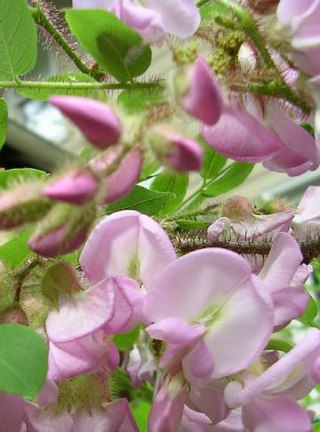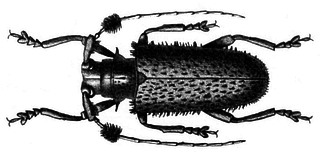
The ringed seal is an earless seal inhabiting the Arctic and sub-Arctic regions. The ringed seal is a relatively small seal, rarely greater than 1.5 m in length, with a distinctive patterning of dark spots surrounded by light gray rings, hence its common name. It is the most abundant and wide-ranging ice seal in the Northern Hemisphere, ranging throughout the Arctic Ocean, into the Bering Sea and Okhotsk Sea as far south as the northern coast of Japan in the Pacific and throughout the North Atlantic coasts of Greenland and Scandinavia as far south as Newfoundland, and including two freshwater subspecies in northern Europe. Ringed seals are one of the primary prey of polar bears and killer whales, and have long been a component of the diet of indigenous people of the Arctic.

Robinia is a genus of flowering plants in the family Fabaceae, tribe Robinieae, native to North America. Commonly known as locusts, they are deciduous trees and shrubs growing 4–25 metres (13–82 ft) tall. The leaves are pinnate with 7–21 oval leaflets. The flowers are white or pink, in usually pendulous racemes. Many species have thorny shoots, and several have sticky hairs on the shoots.

Benincasa hispida, the wax gourd, also called ash gourd, white gourd, winter gourd, winter melon, tallow gourd, ash pumpkin, Chinese preserving melon, is a vine grown for its very large fruit, eaten as a vegetable when mature. It is the only member of the genus Benincasa.

Angophora is a genus of nine species of trees and shrubs in the myrtle family, Myrtaceae. Endemic to eastern Australia, they differ from other eucalypts in having juvenile and adult leaves arranged in opposite pairs, sepals reduced to projections on the edge of the floral cup, four or five overlapping, more or less round petals, and a papery or thin, woody, often strongly ribbed capsule. Species are found between the Atherton Tableland in Queensland and south through New South Wales to eastern Victoria, Australia.

Robinia hispida, known as the bristly locust, rose-acacia, or moss locust, is a shrub in the subfamily Faboideae of the pea family Fabaceae. It is native to the southeastern United States, and it is present in other areas, including other regions of North America, as an introduced species. It is grown as an ornamental and can escape cultivation and grow in the wild.

Nepenthes hispida is a tropical pitcher plant species native to Borneo. It grows at elevations of 100 to 800 m in kerangas forest. It is known with certainty only from Lambir Hills National Park and surrounding areas.

Acalypha hispida, the chenille plant, is a flowering shrub which belongs to the family Euphorbiaceae, the subfamily Acalyphinae, and the genus Acalypha. Acalypha is the fourth largest genus of the family Euphorbiaceae, and contains many plants native to Hawaii and Oceania.

The hairy slit-faced bat is a species of slit-faced bat widely distributed throughout forests and savannas in Africa. Two recognized subspecies exist: N. h. hispida and N. h. pallida. Various forest populations in western and central Africa may represent separate species, although this had not been confirmed as of 2007.

The Andaman spiny shrew or Andaman shrew is a species of mammal in the family Soricidae. It is endemic to India. Its natural habitat is subtropical or tropical dry forests.

Angophora hispida grows as a mallee, or as a tree to about 7 m (25 ft) in height. A. hispida's small size, especially when compared to its Angophora and Eucalyptus relatives, leads to it being known by the common name dwarf apple. It is native to a relatively small patch of central New South Wales – from just south of Sydney up to the Gosford area. The plant's leaves are sessile (stalk-less) and hug the stem with heart-shaped bases. Its previous name – A. cordifolia – referred to these cordate leaves. Another distinctive feature are the red bristly hairs that cover the branchlets, flower bases and new growth. This leads to the specific epithet hispida.

Ficus hispida also known as the opposite leaf Fig is a small but well distributed species of tropical fig tree. It is morphologically gynodioecious, but functionally dioecious. Male trees are hermaphrodites with both staminate flowers that produce pollen and pistillate flowers that produce almost no seeds but can form galls containing pollinator wasp larvae. Female trees have pistillate flowers that do produce seeds but are inhospitable to pollinator wasp larvae.

Aristobia approximator is a species of medium-large, brightly coloured longhorn beetle found in Mainland Southeast Asia, northeastern India and southeastern China.

Aristobia angustifrons is a species of beetle in the family Cerambycidae. It was described by Charles Joseph Gahan in 1888. It is known from Thailand, China and Myanmar.

Aristobia freneyi is a species of beetle in the family Cerambycidae. It was described by Schmitt in 1992. It is known from Thailand.

Aristobia horridula is a species of beetle in the family Cerambycidae. It was described by Frederick William Hope in 1831, originally under the genus Lamia. It is known from Myanmar, Laos, Taiwan, China, Thailand, and Vietnam.
Aristobia quadrifasciata is a species of beetle in the family Cerambycidae. It was described by Per Olof Christopher Aurivillius in 1916 and is known from Sumatra and Malaysia.

Aristobia umbrosa is a species of beetle in the family Cerambycidae. It was described by James Thomson in 1865, originally under the genus Celosterna. It is known from Malaysia, Borneo and Sumatra. It contains the varietas Aristobia umbrosa var. variefasciata.
Aristobia vietnamensis is a species of beetle in the family Cerambycidae. It was described by Stephan von Breuning in 1972. It is known from Vietnam.

Aristobia voeti is a species of beetle in the family Cerambycidae. It was described by James Thomson in 1878. Although the name was originally spelled as "voetii", this spelling was not in use between 1894 and 2014, and therefore the spelling "voeti" must be preserved under ICZN Article 33.3.1, as this is the spelling that is in prevailing usage. It is known from Laos, China and Myanmar.

Aristobia reticulator is a species of beetle in the family Cerambycidae. It is known from Bhutan, Myanmar, India, China, Laos, Bangladesh, Thailand, and Vietnam. It feeds on Prunus persica, Liquidambar formosana, Quercus acutissima, Prunus salicina, and Nephelium mutabile. Many references list the name as Aristobia testudo, but this name, though published earlier, is unavailable under the ICZN, primarily in that Johann Eusebius Voet's 1778 work giving the name testudo fails to fulfill the requirement in ICZN Article 11.4 that a work must be consistently binomial; none of Voet's 1778 names, including testudo, are available.

















